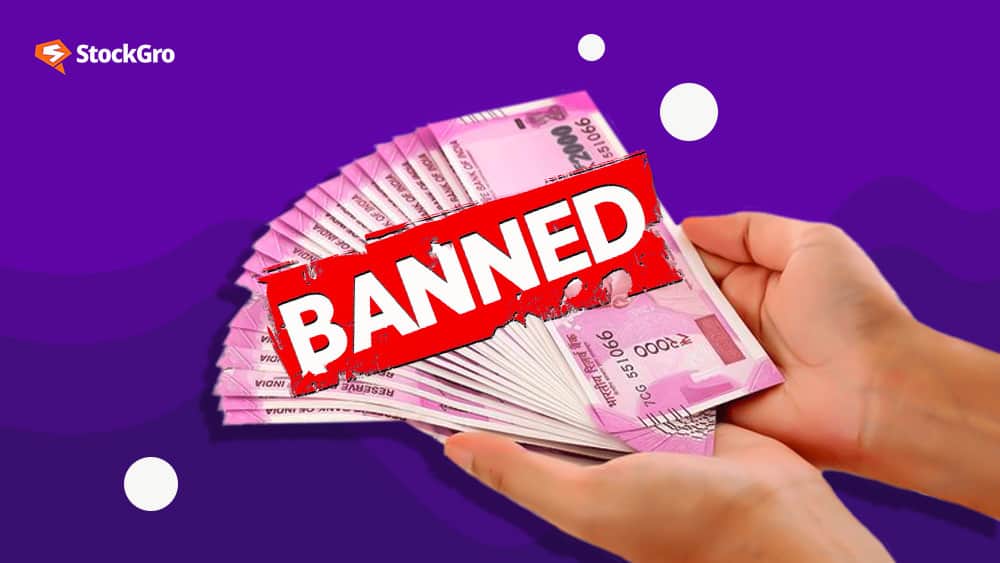
Breaking news: The Reserve Bank of India (RBI) has decided to withdraw Rs. 2000 notes from circulation. Of course, it will remain a legal tender. But each citizen is required to deposit these notes in their bank account on or before September 30, 2023.
Doesn’t this remind you of the infamous ‘2016 Indian banknote demonetisation’? When Rs. 500 and Rs. 1000 notes were rendered invalid. That move did create a fair bit of chaos. So, naturally, the withdrawal of Rs. 2000 note is enough to instil fear. Or maybe, just confusion.
Why did RBI decide to withdraw the Rs. 2000 note? Will this move impact the Indian economy? If yes, how?
Well, time to answer all these questions.
RBI withdraws Rs. 2000 notes from circulation
On May 19, 2023, the Reserve Bank of India (RBI) issued a circular, taking everyone by surprise. Suddenly, the apex bank planned to withdraw Rs. 2000 notes from circulation. But of course, the financial watchdog did provide some clarity.
Thus, before digging up more ‘complex’ topics, let’s take a look at what the bank had to say:
A bit of history into Rs. 2000 banknote
As per the RBI circular, the Rs. 2000 banknote was introduced around 7 years ago, in November 2016, of course, in line with Section 24 of the RBI Act, which says-
Subject to the provisions of sub-section (2) bank notes shall be of the denominational value to two rupees, five rupees, ten rupees, twenty rupees, fifty rupees, one hundred rupees, five hundred rupees, one thousand rupees, five thousand rupees and ten thousand rupees or of such other denominational values, not exceeding ten thousand rupees, as the Central Government may, on the recommendation of the Central Board, specify in this behalf.
Remember the demonetisation mentioned before? Well, the Rs. 2000 banknote was introduced around the same time. Why? To compensate for the lack of currency notes. Thus, keeping the number of rupees in circulation the same. Just the denominations differ.
When did RBI stop printing Rs. 2000 banknotes?
Introducing the Rs. 2000 note was just an interim solution. Not a permanent one. This isn’t an assumption but something the apex bank stated:
The objective of introducing ₹2000 banknotes was met once banknotes in other denominations became available in adequate quantities. Therefore, the printing of ₹2000 banknotes was stopped in 2018-19.
In a nutshell, post FY 2018-19, no new Rs. 2000 notes were printed. And so, it all adds up to why the government wants to invalidate these notes. After all, for the common man, getting a change of notes for Rs. 2000 was a struggle in itself. No more of that, thank the lords!
Even the RBI agreed as it observed how India’s highest denomination is not being used that often in transactions.
But wait, if the RBI has decided to invalidate the Rs. 2000 denomination, how many notes exist in the economy? Well, no need to do complex maths. The bank already gave out year-wise figures.
How many Rs. 2000 banknotes exist in the economy?
Following are some key figures to understand how many Rs. 2000 bank notes does India have to deposit, for this withdrawal to be deemed ‘successful’:
- 89 percent of Rs. 2000 notes issued prior to March 2017
- The total value of these banknotes = Rs. 6 lakh crore (as on March 31, 2018)
- The total value of these banknotes = Rs. 3.62 lakh crore (as on March 31, 2023)
- Circulation of Rs.2000 notes reduced from 37.3 percent to 10.8 percent, during the 2018-2023 period
What do these figures suggest? In the past five years, the apex bank gradually decided to reduce the number of Rs. 2000 notes, as other notes gained volume. And with just 10 percent currently in circulation, this demonetisation move would not be as intense as the one in 2016. Sigh of relief!
The objective of introducing ₹2000 banknotes was met once banknotes in other denominations became available in adequate quantities. Therefore, the printing of ₹2000 banknotes was stopped in 2018-19.
In a nutshell, post FY 2018-19, no new Rs. 2000 notes were printed. And so, it all adds up to why the government wants to invalidate these notes. After all, for the common man, getting a change of notes for Rs. 2000 was a struggle in itself. No more of that, thank the lords!
Even the RBI agreed as it observed how India’s highest denomination is not being used that often in transactions.
But wait, if the RBI has decided to invalidate the Rs. 2000 denomination, how many notes exist in the economy? Well, no need to do complex maths. The bank already gave out year-wise figures.
You may also like: The 20% TCS buzz and its impact on international credit cards
How many Rs. 2000 banknotes exist in the economy?
Following are some key figures to understand how many Rs. 2000 bank notes does India have to deposit, for this withdrawal to be deemed ‘successful’:
- 89 percent of Rs.2000 notes issued prior to March 2017
- The total value of these banknotes = Rs. 6 lakh crore (as on March 31, 2018)
- The total value of these banknotes = Rs. 3.62 lakh crore (as on March 31, 2023)
- Circulation of Rs.2000 notes reduced from 37.3 percent to 10.8 percent, during the 2018-2023 period
What do these figures suggest? In the past five years, the apex bank gradually decided to reduce the number of Rs. 2000 notes, as other notes gained volume. And with just 10 percent currently in circulation, this demonetisation move would not be as intense as the one in 2016. Sigh of relief!
Life span of Indian currency notes
Most denominations under our beloved Indian Rupee (INR) were previously printed on paper or less-durable material. And thus, after reacting with the chemicals present around, these notes would soil faster. Worse, these notes would tear up after a certain point.
According to an earlier report by the Times of India, the lifespan of Indian banknotes back in 2012 were as follows:
| Denomination | Lifespan |
| Rs. 10 | Approx. 2 years |
| Rs. 100 | 3-4 years |
| Rs. 500 | 5-7 years |
| Rs. 1000 | 5-7 years |
The current series of Indian rupee banknotes are made of pulp containing cotton and balsam, rags, etc. Thus, more durable and less prone to damage by use or chemical reaction. Even then, the Rs. 2000 note has a mere 4-5-year lifespan, confirmed the RBI.
With most of the Rs.2000 notes being printed five years ago, they have already surpassed their lifespan. This makes it the perfect opportunity to withdraw the denomination. And slowly, the pieces of the puzzle come together!
Also Read: How to benchmark like a boss: Your guide to investment success!
What is RBI’s ‘Clean Note Policy’?
In their press release, the apex bank also made a mention of its ‘Clean Note Policy’. Well, the policy pertains to the quality of paper notes as well as other security features.
According to the Indian Express, RBI’s Clean Note Policy aims to provide good-quality notes and notes to India’s citizenry. While newer notes get better features, they gradually withdraw the older soiled notes.
Did you know, in 2014, the apex bank issued a circular announcing the withdrawal of all currency notes printed up to 2005? For convenience’s sake, older notes would remain legal tenders for transactions. The authorities asked the citizens to approach their nearest banks and get their notes replaced.
The Reserve Bank of India has today advised that after March 31, 2014, it will completely withdraw from circulation all banknotes issued prior to 2005. From April 1, 2014, the public will be required to approach banks for exchanging these notes. Banks will provide exchange facility for these notes until further communication. The Reserve Bank further stated that the public can easily identify the notes to be withdrawn as the notes issued before 2005 do not have on them the year of printing on the reverse side. (QUOTE) – January 2022, 201 circular
The RBI’s withdrawal of the Rs. 2000 note doesn’t appear too surprising, does it? The apex bank has announced such a move before. And since the situation involves invalidating only one denomination, it simplifies the situation compared to the ‘2016 demonetisation’ move.
Thus, with this clarity in mind, we can answer the final question –
Also Read: Startup success: Swiggy turns profitable almost 9 years after inception
Will RBI’s Rs. 2000 note withdrawal impact the economy?
Fortunately, this question has a simple answer – ‘no’. Unlike the 2016 demonetisation move, withdrawing Rs. 2000 banknotes would not impact the Indian economy. So, Dalal Street traders take a sigh of relief.
With smaller denominations are being used more and digital transactions dominating the payments space, this move might just fade away in the background.
After all, Dalal Street has more important things to think about. Like the US crossing its debt ceiling!

